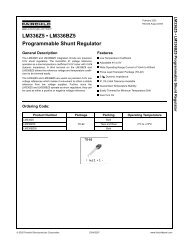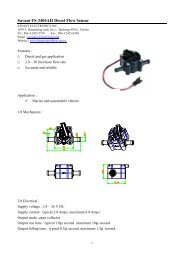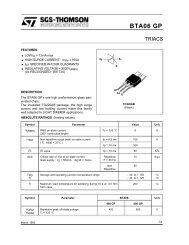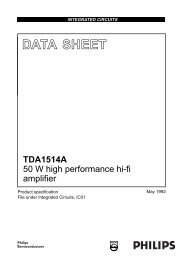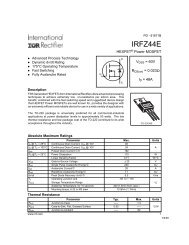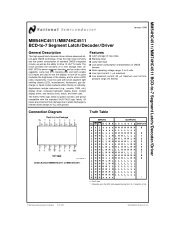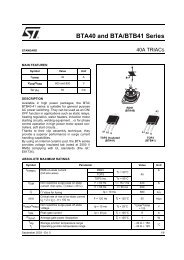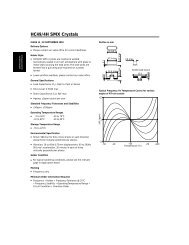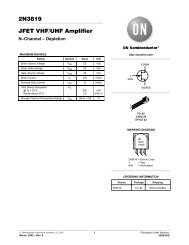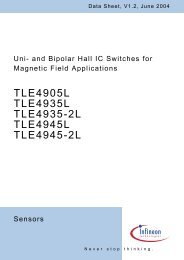LM6171 High Speed Low Power Low Distortion Voltage ... - Micropik
LM6171 High Speed Low Power Low Distortion Voltage ... - Micropik
LM6171 High Speed Low Power Low Distortion Voltage ... - Micropik
Create successful ePaper yourself
Turn your PDF publications into a flip-book with our unique Google optimized e-Paper software.
<strong>LM6171</strong><br />
<strong>LM6171</strong> Simplified Schematic<br />
01233610<br />
Application Information<br />
<strong>LM6171</strong> PERFORMANCE DISCUSSION<br />
The <strong>LM6171</strong> is a high speed, unity-gain stable voltage feedback<br />
amplifier. It consumes only 2.5 mA supply current while<br />
providing a gain-bandwidth product of 100 MHz and a slew<br />
rate of 3600V/µs. It also has other great features such as low<br />
differential gain and phase and high output current. The<br />
<strong>LM6171</strong> is a good choice in high speed circuits.<br />
The <strong>LM6171</strong> is a true voltage feedback amplifier. Unlike<br />
current feedback amplifiers (CFAs) with a low inverting input<br />
impedance and a high non-inverting input impedance, both<br />
inputs of voltage feedback amplifiers (VFAs) have high impedance<br />
nodes. The low impedance inverting input in CFAs<br />
will couple with feedback capacitor and cause oscillation. As<br />
a result, CFAs cannot be used in traditional op amp circuits<br />
such as photodiode amplifiers, I-to-V converters and integrators.<br />
<strong>LM6171</strong> CIRCUIT OPERATION<br />
The class AB input stage in <strong>LM6171</strong> is fully symmetrical and<br />
has a similar slewing characteristic to the current feedback<br />
amplifiers. In the <strong>LM6171</strong> Simplfied Schematic, Q1 through<br />
Q4 form the equivalent of the current feedback input buffer,<br />
R E the equivalent of the feedback resistor, and stage A<br />
buffers the inverting input. The triple-buffered output stage<br />
isolates the gain stage from the load to provide low output<br />
impedance.<br />
<strong>LM6171</strong> SLEW RATE CHARACTERISTIC<br />
The slew rate of <strong>LM6171</strong> is determined by the current available<br />
to charge and discharge an internal high impedance<br />
node capacitor. The current is the differential input voltage<br />
divided by the total degeneration resistor R E . Therefore, the<br />
slew rate is proportional to the input voltage level, and the<br />
higher slew rates are achievable in the lower gain configurations.<br />
When a very fast large signal pulse is applied to the input of<br />
an amplifier, some overshoot or undershoot occurs. By placing<br />
an external series resistor such as 1 kΩ to the input of<br />
<strong>LM6171</strong>, the bandwidth is reduced to help lower the overshoot.<br />
LAYOUT CONSIDERATION<br />
Printed Circuit Boards and <strong>High</strong> <strong>Speed</strong> Op Amps<br />
There are many things to consider when designing PC<br />
boards for high speed op amps. Without proper caution, it is<br />
very easy and frustrating to have excessive ringing, oscillation<br />
and other degraded AC performance in high speed<br />
circuits. As a rule, the signal traces should be short and wide<br />
to provide low inductance and low impedance paths. Any<br />
unused board space needs to be grounded to reduce stray<br />
signal pickup. Critical components should also be grounded<br />
at a common point to eliminate voltage drop. Sockets add<br />
capacitance to the board and can affect frequency performance.<br />
It is better to solder the amplifier directly into the PC<br />
board without using any socket.<br />
Using Probes<br />
Active (FET) probes are ideal for taking high frequency<br />
measurements because they have wide bandwidth, high<br />
input impedance and low input capacitance. However, the<br />
probe ground leads provide a long ground loop that will<br />
produce errors in measurement. Instead, the probes can be<br />
grounded directly by removing the ground leads and probe<br />
jackets and using scope probe jacks.<br />
Components Selection And Feedback Resistor<br />
It is important in high speed applications to keep all component<br />
leads short because wires are inductive at high frequency.<br />
For discrete components, choose carbon<br />
www.national.com 16




